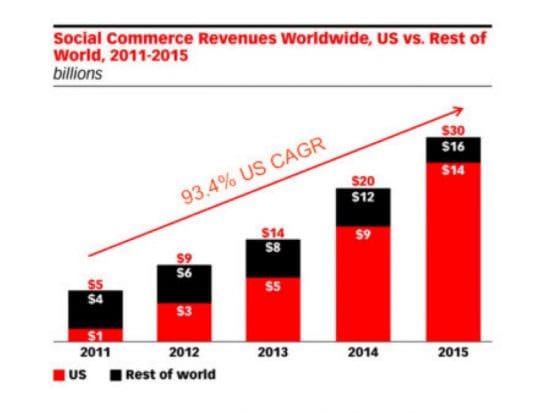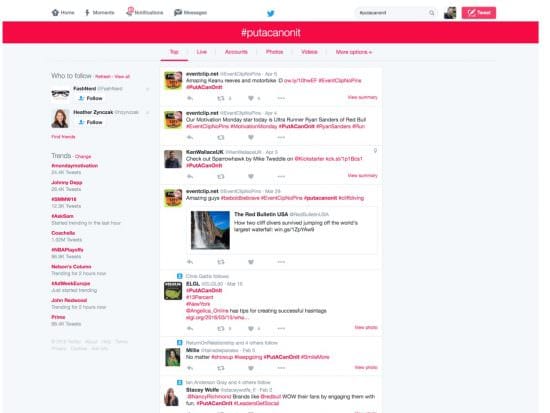Social media strategy and planning essentials series
The social media landscape is constantly evolving. New networks rise to prominence (e.g. Snapchat), new technology increases user participation and real-time content (e.g. Periscope) and existing networks enhance their platform and product (e.g. Facebook,Twitter, Pinterest and Instagram launching ‘buy’ buttons). Organic reach is also shrinking as the leading networks ramp up their paid channels to monetise platform investment.
If the first era of social was engagement, the new era is acquisition and conversion. Social commerce is growing much faster than retail ecommerce, although it’s early days. The top 500 retailers earned $3.3bn from social commerce in 2014, up 26%. Many retailers I work with are seeing social driving bigger % increases in retail traffic than any other channel.

Social is no longer just about conversation and content; it’s now an established channel for customer acquisition, remarketing and engaging existing fans/customers to support retention programs. It may be relatively immature compared to search and email marketing but it’s a channel in which most ecommerce teams are ramping up investment (people and tools).
This article discusses how organic and paid social media fit into your social strategy.
Defining organic and paid social media marketing
This is for people new to social media, if you already understand what each means, skip to the next section.
Organic social
Using free tools provided by each social network to build a social community and interact with it, sharing posts and responding to customer comments.
For example, using Hootsuite or Buffer to schedule and publish tweets on Twitter is organic. You may pay for a license to use Hootsuite or Buffer, put there is no charge from Twitter for publishing your tweets.
Paid social
Paying to display adverts (whatever the format – text, image, video, carousel etc.) or sponsored messages to social network users based on user profile e.g. demographic. A cost is incurred depending on the type of ad planned; for example many ads incur a cost per click (cpc).
“Many ecommerce practitioners are familiar with the pay-per-click model from their dealings with search engines, however whilst many paid social campaigns will also charge on a per-click basis the path to conversion may not be as direct as with search, if transactional at all.
Whilst the targeting capabilities of paid social are beyond doubt, marketers need to be aware of the different mind-set of social users when compared to that of a user conducting a transactional search query, and should use this to tailor their messaging.
Paid social adds another channel to an already crowded and fragmented conversion funnel, keeping track of return on investment is key.”
Stuart Kerr, Head of Digital at Liberty Games @stukerr
Do people really buy from social content/offers?
Research from Crowdtap revealed 64% of 3,000 people surveyed use social to find inspiration for shopping (up 51% vs. prior year)
This is driven by retailers targeting consumers with personalised offers and deals on social networks:
- Nearly half (46%) of social media users are already using social platforms while thinking about making a purchase.
- 40% of users are actively deciding what to buy based on what they have seen on social media platforms, including reviews and recommendations, and this is only set to grow.
Yes this is only one bit of research and there are no guarantees, but social commerce is the present, not the future. It’s expected that buying through social media will only increase.
So let’s look at how organic and paid support 4 key social media marketing activities.
Listening, learning and responding
Organic is ideal for community management. You don’t need paid campaigns to listen to what people are saying about/to you.
However, you can use paid campaigns to reinforce core messages that you’ve shared via organic posts. For example, if the company has been involved in a public crisis (think Volkswagen and the emissions crisis), then information you’ve provided to people who have contacted you can be used as part of a wider educational marketing program with paid ads to extend the message reach.
What’s important is that the listening and learning elements are part of your organic approach to social media; they should happen naturally by being actively involved with your community. If you’re not responding effectively on a personal level to enquiries and complaints, a paid program may attract further criticism.
Creating conversations based on a unifying thread
Social marketers look for ways to engage groups of people based on a shared interest/passion. Whilst one-to-one communication is the much-touted holy grail of social marketing, the impact and efficiency of communicating to a wider audience simultaneously is important to understand.
Hashtags are a great example. You can create a hashtag for free, or simply dovetail with an existing hashtag if what you’re doing/saying is relevant to that audience.
By using a hashtag for a specific conversation, you can unify all posts into a searchable thread that helps individuals to be part of the conversation and follow what others are saying. It also helps foster new connections, as like-minded people can find each other based on a shared interest/passion.
Below is an example from RedBull, masters of content marketing and community building.

Here’s a great write-up from Michael Patterson of 7 examples of successful hashtag campaigns.
Here’s a personal experience of this. Along with ecommerce consultant Dan Barker, I launched EcomChat in 2013, a weekly Twitter chat on all things ecommerce based around the #EcomChat hashtag. It has achieved the following:
- Provided a great way to connect with ecommerce and digital marketing specialists
- Built a community that wants to share knowledge and learn from others
- People now use the hashtag to share interesting ecommerce news outside the chat and ask questions/share information
- People have made new connections and this has led to collaboration for ecommerce projects
- More than 1,450 ecommerce and digital marketing followers.
It doesn’t cost a penny to run the chat, other than our time, and it has created a highly engaged mini-community on Twitter.
Using social for content marketing
A content plan should sit above all your marketing channels, defining the key stories and when they play.
Social media can then be used to help tell these stories, whether it’s through one-off announcements (e.g. Facebook post), or a series of short posts that build the story over time (e.g. series of blogs, each being shared on key networks).
You can also use organic to increase audience engagement with your content. For example, let’s say you’re a ticketing website for sporting events and you know that some of your followers are rugby fanatics. If you have a new blog interviewing Dylan Hartley (current England captain), then it makes sense to personally contact them (or at least key influencers) via their preferred social network and tell them about the blog, and ask them to comment/share. It’s personal and increases the chance they’ll see/read your content.
Of course, you need to be pragmatic about how many people you can contact individually. There is a resource implication but the scale of this can grow overtime as you learn what impact it has. Typically this is a core organic marketing competency of a Community Manager.
You don’t need to pay to share, but you do need an audience. When first starting out, you’ll have few people to talk to via social, so the relative impact of your content will be low (unless you have a few amazing influencers whose sharing of your content resonates with a far larger audience).
The example below is from Liberty Games paying to promote content via Facebook ads:

Paid social can help amplify organic content, using social network advertising tools to target the audience. Using the rugby example, on Facebook you could target people who like other leading rugby fan pages. I recommend testing paid social campaigns to promote key content assets like reports and highlight important news/announcements. With a small budget you can quickly measure amplification impact.
I’ve done this successfully myself, for example using sponsored Twitter ads to promote events for a crowdfunding startup, which helped sell tickets and increase followers. I started with a £100 budget and then expanded based on results.
The next article in this series focuses on the role of content in social media marketing, so pleas keep an eye out.
Micro targeting people using paid campaigns
Targeting based on interest
You can target people based on self-identified interests. For example, if you are selling pet accessories, you can specifically target social media users who have expressed an interest in pets. Marketers doing this typically experience higher CTR and conversion for social ads than for blanket campaigns.
Remarketing
You should get to grips with Remarketing lists. Remarketing involves marketing to people who have already visited your website, then promoting relevant content/offers based on the context of their visit.
A good example is Facebook Custom Audiences. Within this Facebook supports email targeting, the ability to upload customer email addresses and then target those users on Facebook with tailored ads. This lets you micro-segment based on your existing customer database. One application is customer loyalty marketing, promoting offers to existing high value users via Facebook ads.
The challenge here is to know your own audience. If you have a good CRM database and can profile and segment meaningfully, then you can export highly targeted lists to social media for advertising.
Look alike audiences
The ability to upload customer lists into social advertising accounts lets you create look alike audiences – so targeting other users on the social network who closely match your existing customers.
This taps into a core acquisition marketing principle, the aim to understand core audience profiles and then invest in campaigns that appeal to others matching those criteria.
Your thoughts, comments and personal experience
So this is step 4 in the Smart Insights 12 step series on social media strategy and planning.
Did you find it useful?
What have you learned from doing social media marketing – what do you think the role of organic and paid is? And how should they compliment each other?
Please join in the discussion and share your experience in the comments field at the bottom of this page.
Keep an eye out for next month’s article, “What role does content play in your social media plan?”.
 Thanks to
Thanks to